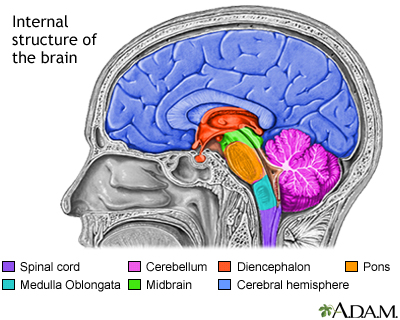Facial tics
Tic - facial; Mimic spasm
A facial tic is a repeated spasm, often involving the eyes and muscles of the face.
Images


I Would Like to Learn About:
Causes
Tics most often occur in children, but may last into adulthood. Tics occur 3 to 4 times as often in boys as girls. Tics may affect as many as one quarter of all children at some time.
The cause of tics is unknown, but stress appears to make tics worse.
Short-lived tics (transient tic disorder) are common in childhood.
A chronic motor tic disorder also exists. It may last for years. This form is very rare compared to the common short-lived childhood tic. Tourette syndrome is a separate condition in which tics are a major symptom.
Symptoms
Tics may involve repeated, uncontrolled spasm-like muscle movements, such as:
- Eye blinking
- Grimacing
- Mouth twitching
- Nose wrinkling
- Squinting
Repeated throat clearing or grunting may also be present.
Exams and Tests
Your health care provider will usually diagnose a tic during a physical examination. No special tests are needed. In rare cases, an electroencephalogram (EEG) may be done to look for seizures, which can be the cause of tics.
Treatment
Short-lived childhood tics are usually not treated. Calling the child's attention to a tic may make it worse or cause it to continue. A non-stressful environment can make tics occur less often, and help them go away more quickly. Stress reduction programs or cognitive behavioral intervention may also be helpful.
If tics severely affect a person's life, medicines may help control them.
Outlook (Prognosis)
Simple childhood tics should go away on their own over a period of months. Chronic tics may continue for a longer period of time.
Possible Complications
In most cases, there are no complications.
When to Contact a Medical Professional
Make an appointment with your provider if tics:
- Affect many muscle groups
- Are persistent
- Are severe
Prevention
Many cases cannot be prevented. Reducing stress may be helpful. Sometimes, counseling can help your child learn how to cope with stress.
Related Information
Provisional tic disorderChronic motor or vocal tic disorder
Tourette syndrome
References
Kim JW, Walter HJ, DeMaso DR. Motor disorders and habits. In: Kliegman RM, St. Geme JW, Blum NJ, et al, eds. Nelson Textbook of Pediatrics. 22nd ed. Philadelphia, PA: Elsevier; 2025:chap 37.
Tochen L, Singer HS. Tics and Tourette syndrome. In: Swaiman KF, Ashwal S, Ferriero DM, et al, eds. Swaiman's Pediatric Neurology: Principles and Practice. 6th ed. Philadelphia, PA: Elsevier; 2017:chap 98.
BACK TO TOPReview Date: 3/31/2024
Reviewed By: Joseph V. Campellone, MD, Department of Neurology, Cooper Medical School at Rowan University, Camden, NJ. Review provided by VeriMed Healthcare Network. Also reviewed by David C. Dugdale, MD, Medical Director, Brenda Conaway, Editorial Director, and the A.D.A.M. Editorial team.

Health Content Provider
06/01/2025
|
A.D.A.M., Inc. is accredited by URAC, for Health Content Provider (www.urac.org). URAC's accreditation program is an independent audit to verify that A.D.A.M. follows rigorous standards of quality and accountability. A.D.A.M. is among the first to achieve this important distinction for online health information and services. Learn more about A.D.A.M.'s editorial policy, editorial process and privacy policy. A.D.A.M. is also a founding member of Hi-Ethics. This site complied with the HONcode standard for trustworthy health information from 1995 to 2022, after which HON (Health On the Net, a not-for-profit organization that promoted transparent and reliable health information online) was discontinued. |
The information provided herein should not be used during any medical emergency or for the diagnosis or treatment of any medical condition. A licensed medical professional should be consulted for diagnosis and treatment of any and all medical conditions. Links to other sites are provided for information only -- they do not constitute endorsements of those other sites. © 1997- 2025 A.D.A.M., a business unit of Ebix, Inc. Any duplication or distribution of the information contained herein is strictly prohibited.
